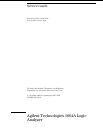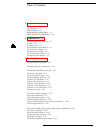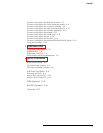
Table of Contents
1 General Information
Accessories 1–2
Specifications 1–3
Characteristics 1–3
Supplemental Characteristics 1–4
Recommended Test Equipment 1–8
2 Preparing for Use
To inspect the logic analyzer 2–2
Ferrites 2–3
To apply power 2–4
To operate the user interface 2–4
To set the line voltage 2–4
To degauss the display 2–5
To clean the logic analyzer 2–5
To test the logic analyzer 2–5
3 Testing Performance
To perform the self-tests 3–3
To make the test connectors 3–6
To test the threshold accuracy 3–8
Set up the equipment 3–8
Set up the logic analyzer 3–9
Connect the logic analyzer 3–9
Test the TTL threshold 3–10
Test the ECL threshold 3–12
Test the − User threshold 3–13
Test the + User threshold 3–14
Test the 0 V User threshold 3–15
Test the next pod 3–16
To test the glitch capture 3–17
Set up the equipment 3–17
Set up the logic analyzer 3–18
Connect the logic analyzer 3–18
Test the glitch capture on the connected channels 3–20
Test the next channels 3–22
To test the single-clock, single-edge, state acquisition 3–23
Set up the equipment 3–23
Set up the logic analyzer 3–24
Connect the logic analyzer 3–26
Verify the test signal 3–27
Check the setup/hold combination 3–29
v


















